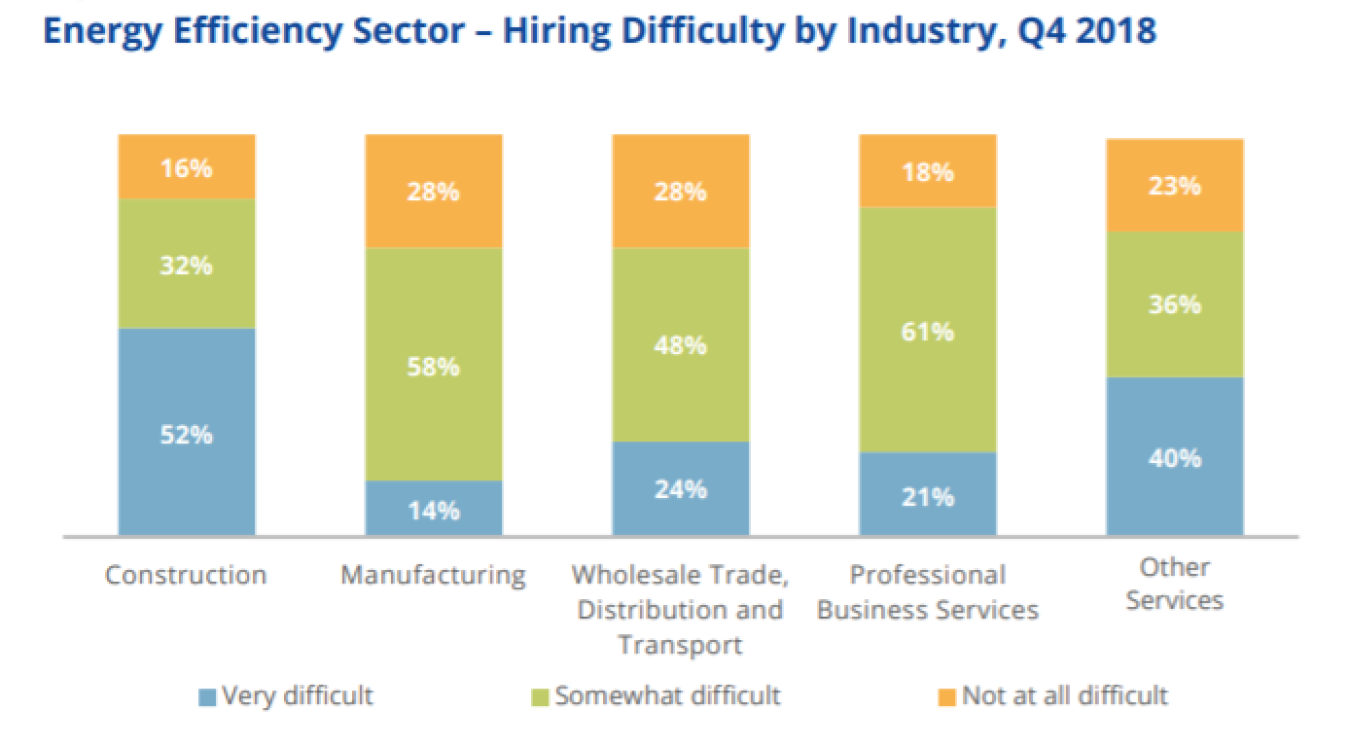BTO researches, develops, and validates building technologies that are helping the United States achieve a clean and affordable energy future.
September 18, 2019By Madeline Salzman and Mary Hubbard
The U.S. Department of Energy’s Building Technologies Office (BTO), within the Office of Energy Efficiency and Renewable Energy, researches, develops, and validates building technologies that are helping the United States achieve a clean and affordable energy future. But it will take more than technology alone to achieve a vision of a stronger and more prosperous America. Energy infrastructure may power America, but it only works when a skilled workforce connects the wires, pours the concrete, and seals the gaps. That said, too few Americans participate in the energy-efficiency workforce overall, and of those, few have the necessary skills and expertise to install and maintain cutting-edge efficiency technologies in the retrofit and new construction markets. Numerous surveys and analyses of the energy-efficiency jobs market demonstrate an inability to find qualified staff and subcontractors, and the labor gap is only getting worse.

When jobs remain unfilled – or underfilled by workers lacking necessary knowledge and skills – building and retrofit prices go up, projects are delayed, and opportunities for energy savings go unaddressed. Projects that do get completed are less likely to achieve the full performance expected from product design if workers don’t have the necessary skills. System faults can result from poor installation and reduce energy savings by 10-35%, limiting the many benefits efficiency improvements have to offer.
As part of the Advanced Building Construction (ABC) Initiative, BTO will fund new and improved training programs and apprenticeships geared at enhancing today’s workforce as well as growing a workforce capable of ensuring energy efficiency in new construction and retrofit practices of the future. BTO programs like the Solar Decathlon (now BuildingsNEXT) and Jump into STEM, alongside workforce resources like the Better Buildings Workforce Guidelines, and the Home Improvement Expert™ Checklists have made progress on this front already, and continue to do so. ABC is adding to these efforts through a coordinated strategy to target systemic problems across the industry as well as train and re-skill “future-focused” workers to produce and upgrade more affordable, comfortable, and high-quality homes and buildings. Best practices, training curricula, and other open-source resources will be used locally by active partners and disseminated more broadly through a variety of avenues, including the Building America Solution Center, to trainers and others who want to update or revamp their materials.
BTO is making great strides to grow the skilled energy-efficiency workforce. For example:
- Attracting new people to good jobs. BTO is looking to recruit, train, and retrain veterans and active duty military personnel who are transitioning to the workforce, a group that could benefit from access to jobs in the energy-efficiency field. BTO will work with industry and nonprofit groups to recruit and better message the high potential for well-paid, meaningful employment in the energy-efficiency industry. There are currently hundreds of thousands of unfilled construction-related energy-efficiency jobs. These jobs pay well, offer stability, and allow workers to solve complex problems by building real solutions that deliver benefits for the greater good. However, many Americans are unaware of these opportunities or the skills training needed for such jobs. Over half of students surveyed by the EGIA Foundation say they know “nothing at all” about heating, ventilation, and air conditioning (HVAC) work. Additionally, many bright, hard-working people simply do not see themselves in this industry: Less than one in four energy-efficiency workers are women; Latinos, Asian Americans, and African Americans are underrepresented in energy efficiency compared to the national workforce.
- Field-validating and sharing high-quality workforce training resources. New energy-efficiency technologies become available every day on the market, making it challenging for job trainers to stay up to date on best practices for installing and maintaining the latest equipment. As part of its workforce strategy, BTO plans to work with groups that can create and test training resources and prove which ones best prepare energy-efficiency workers to produce and install high-quality products.
- Leveraging and building from existing licensing and training infrastructure. BTO seeks to leverage existing training and certification infrastructure to assist a transitioning workforce in embracing and effectively incorporating new energy technologies as well as related design and construction practices. Most states administer education and training programs for construction industry professionals, including licensing, certification, and continuing education for builders, contractors, designers, building officials, and other key trades. Many states incorporate specific requirements based on minimally acceptable practices, typically based on applicable building codes. As industry building codes and standards are regularly updated, existing education and training programs must adapt to incorporate modern practices, representing both a challenge and an opportunity for technological advancement.
America’s energy-efficiency workforce for buildings needs to be ready to install, maintain, operate, and verify the best equipment of today, and also the best equipment of tomorrow. By researching and developing tomorrow’s building efficiency technologies, BTO is helping streamline the pathway to energy efficiency for more Americans through an enhanced workforce.
Find out more and get involved with ABC by viewing BTO's blog posts and related announcements.

